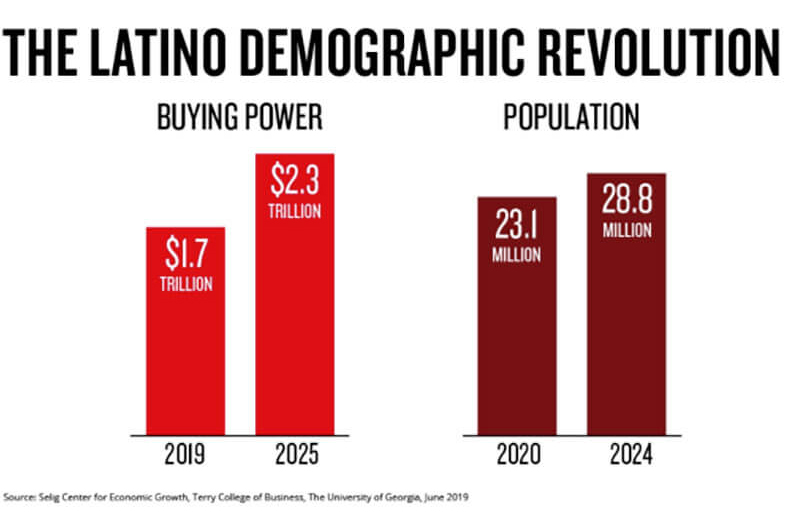Nielsen’s latest Diverse Intelligence Series consumer report, Cultural Connectivity Transformed: How Latinos Are Connecting While Social Distancing, explores how the Latino community is communicating through the COVID-19 pandemic.
As one of the groups to feel the disproportionate effects of job loss and health impacts during the COVID-19 pandemic, Latinos have come to rely on media and social channels more than ever to educate, inform and entertain. And although this group continues to face significant challenges, they are not buckling under pressure. Instead, they are tapping into their collectivist culture and virtual social networks to stay connected, weathering the storm by tapping into their resilient roots.
The report demonstrates how trusted influencers, brands and media are leveraged both pre-COVID and during the pandemic, to keep Latinos engaged, entertained, but most importantly, informed. Data indicates that these networks will remain the trusted conduits for information transfer within the Latino community for the post-pandemic recovery.
Latinos continue to be key factors in stimulating the country’s economy with their immense buying power, which increased by 69 percent in just nine years, outpacing non-Hispanics, which increased by 41 percent during the same time.
“Hispanics are a collectivist culture, placing strong value on the needs of the community as a whole and maintaining close connections with each other. As COVID-19 began to spread, the subsequent social distancing measures threatened the in-person social networks that Latinos relied upon,” said Stacie de Armas, SVP of strategic initiatives and consumer engagement. “The Latino community has long exhibited an outsized use of digital connections, however as a result of the circumstances of COVID-19, Latinos intensified their use of digital platforms to a greater degree than the total market, including use of social media and trusted content channels such as TV and radio to inform, communicate, share experiences and seek support.”
Key insights from the Diverse Intelligence Series report include:
- The U.S. Hispanic population frequently makes headlines for its growth and for being a key contributor to the economy, labor force and the electorate.
- Latinos will be the primary contributors to total U.S. population growth for the next 40 years, comprising 53 percent of the growth in the next five years and 68 percent of the growth up to 2060. Latinos will contribute more growth than any other population segment, a factor compounded by a projected growth decline among the non-Hispanic white population.
- In 2019, Hispanics accounted for $1.7 trillion in buying power, which is 11 percent of the total buying power of the U.S.
- Multigenerational households are the nexus of the Hispanic community. Hispanics are 40 percent more likely to live in multigenerational households, and the median age of their households is only 29, compared to 38 years of age in non-Hispanic U.S. households. Over the next 10 years, the disproportionately younger Latino community will over contribute based on their relative size to the economic recovery, through home purchases and the acquisition of goods and services.
- Latinos choose content that is trusted and speaks to them culturally first, regardless of language. Latinos are increasingly connecting with their trusted networks through social media. Latinos are 57 percent more likely to use social media as a primary source of information about COVID-19.
- More than one-third of Hispanics spent more time listening to the radio as a result of COVID-19 (37 percent) compared with only 24 percent of white non-Hispanics. Another 48 percent of Latinos reported that listening to their favorite radio host helped them feel more informed and less stressed.
- As COVID-19 news and health information began to dominate our everyday lives, the mobile phone became a mainstay of connectivity. Ninety-eight percent of the total U.S Hispanic population owns one, and they spend over 30 hours a week on a smartphone.
- Although there was a similar number of Spanish language news and talk shows airing in the category and time period from 2019 to 2020, we see a 71 percent increase in social media activity around those programs vs. the year prior. Social media activity around English language primetime news and talk only increased by 17 percent.
- The smartphone serves as a conduit for Latino essential workers to stay in touch with their families, networks and trusted information sources. Knowing the disproportionate impact of COVID-19 in Latino communities, 61 percent of Hispanics say they have been watching or listening to the news more often, compared with 54 percent of non-Hispanics.
- Video games have come to the forefront of stay-at-home activities for Hispanics during the pandemic.
Hispanic gamers use gaming consoles to stream a variety of content such as gamer commentaries, reviews, live streams and news. Thirty-one percent of all Hispanics say they have increased their time spent playing video games online or on a gaming device since the outbreak. Eight in 10 Hispanic gamers say they have used their mobile device to play video games in the past three months.
“Hispanics rely upon their physical and digital networks as conduits of information, underscoring the interdependence of collectivism and social networks. These networks serve more than just a social appetite; they serve as the conduit of trust, truth and cultural connection,” said Stacie de Armas.
To learn more and download the full report “Cultural Connectivity Transformed: How Latinos are connecting while social distancing”, visit nielsen.com/latinos.
Nielsen launched the Diverse Intelligence Series, a robust portfolio of comprehensive reports which focuses solely on diverse consumers’ unique consumption and purchasing habits. The series has become an industry resource to help brands better understand and reach diverse customers.

